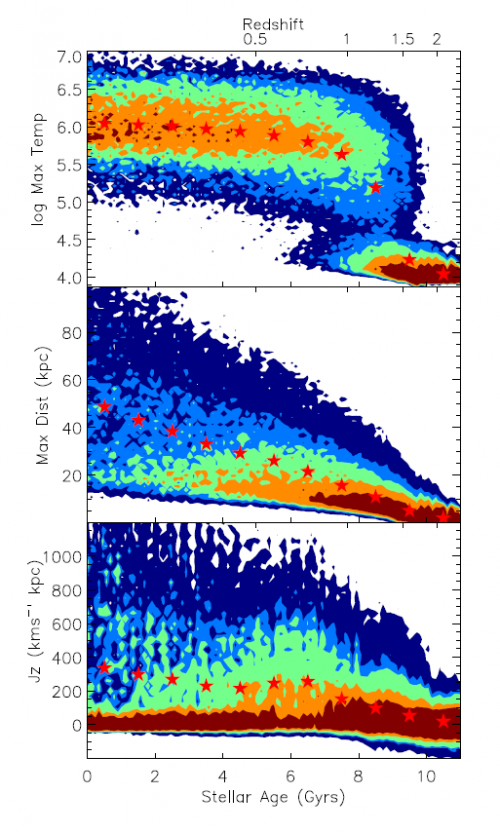
Top panel: the mean of the log of the Maximum Tem-perature that \star forming bulge gas" (BGs, see text) reaches subsequent to the time that it was identi ed, plotted against the age of the stars which form from that BGs. Middle panel: the mean of the maximum distance that star forming bulge gas (BGs) reaches from the centre of the galaxy, plotted against the age of BGs stars. Bottom panel: the mean angular momentum of BGs stars is plotted against their age. Red star symbols show the me-dian values at each age. Supernova feedback heats gas and ejects it from the central region with the hottest gas travelling the fur- thest from the centre. The ejected gas absorbs angular momentum from the hot corona and later accreting gas, returning to the disk with a signi cantly di erent angular momentum distribution.
with a signi cantly di erent angular momentum distribution.Within a fully cosmological hydrodynamical simulation, we form a galaxy which rotates at 140 km/s, and is characterised by two loose spiral arms and a bar, indicative of a Hubble Type SBc/d galaxy. We show that our simulated galaxy has no classical bulge, with a pure disc profile at z=1, well after the major merging activity has ended. A long-lived bar subsequently forms, resulting in the formation of a secularly-formed "pseudo" bulge, with the final bulge-to-total light ratio B/T=0.21. We show that the majority of gas which loses angular momentum and falls to the central region of the galaxy during the merging epoch is blown back into the hot halo, with much of it returning later to form stars in the disc. We propose that this mechanism of redistribution of angular momentum via a galactic fountain, when coupled with the results from our previous study which showed why gas outflows are biased to have low angular momentum, can solve the angular momentum/bulgeless disc problem of the cold dark matter paradigm.
See the webside for more details.http://arxiv.org/PS_cache/arxiv/pdf/1105/1105.2562v1.pdf (SY)

